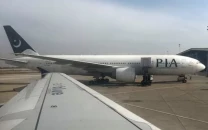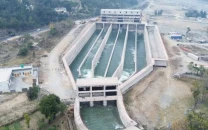Traffic mismanagement continues to choke city
Despite billion-rupee infrastructural investments in signal-free corridors and bus services, gridlocks remain a common

Over the past few decades, traffic jams have emerged as a significant urban dilemma plaguing the city life in Karachi. This is in spite of the fact that eight signal-free corridors costing billions of rupees alongside two Bus Rapid Transit Systems (BRTS) have been constructed to improve the flow of traffic in the port city.
Yet as roads in the city continue to remain choked, a question mark is raised on the competence of the state's urban planners, who have been unable to devise a comprehensive solution to simultaneously resolve traffic jams, provide convenient transport facilities, and minimize accidents.
According to a survey conducted by the Express Tribune, eight signal-free corridors have been constructed in the last two and a half decades with funding from federal, provincial, and former city governments. These include Shahrah-e-Faisal, Sir Shah Suleiman Road, University Road, Rashid Minhas Road, Shahrah-e-Pakistan, Sher Shah Suri Road and the Shaheed-e-Millat Expressway alongside the Lyari Expressway, which was built under the supervision of the National Highway Authority (NHA).
Furthermore, the Green Line project was completed under federal supervision and the Orange Line was built under provincial oversight while the Red Line and Yellow Line BRT projects are still under construction.
Unfortunately, traffic problems persist despite these massive projects, with severe gridlocks observed at various locations including Metropole Hotel, Karsaz, Guru Mandir, Teen Hatti, Liaquatabad No. 10, Karimabad, Water Pump, Ayesha Manzil, Sohrab Goth, and Gulshan Chowrangi from 8-10am and again from 5-8pm. Although the Lyari Expressway itself remains free of congestion, its exit points, such as those at Sohrab Goth and near Gharibabad, face severe traffic jams during peak hours.
The survey also highlighted the abundance of encroachments, potholes, and an increasing number of illegal nine and twelve-seater CNG rickshaws being used as public transport on major roads. These rickshaws often race against each other, stop haphazardly, and pick up or drop off passengers without regard for traffic flow. Moreover, wrong-way driving is also common and remains unchecked by the Traffic Police.
DIG Traffic Ahmed Nawaz believed that traffic encroachments and the operation of 9 and 12-seater CNG rickshaws had worsened the frequency of traffic jams in the bustling port city, which faced a shortage of traffic personnel.
"There are 9,000 Traffic Police posts but at present there are only 5,000 personnel. Furthermore, Central Business Units (CBU), the world over, are located in the center of the city but we have them in District South, causing jams in this area during the morning and evening hours," said Nawaz, who revealed that 0.3 million vehicles were purchased annually in Karachi hence increasing the number of signal-free corridors was a suitable solution.
On the contrary, Syed Amir Hussain, Project Coordinator at the NED University, opined that signal-free corridors had brought more harm than good to the city. "While these projects aimed to resolve traffic congestion, the bottlenecks at intersections continue to cause jams. Conversely, these corridors have encouraged speeding, especially at night, leading to a surge in accidents. In the current situation, reviving the Karachi Circular Railway, increasing the number of public buses, and eliminating encroachments on important highways could prove fruitful," suggested Hussain.
"Each signal-free corridor faces different problems therefore comprehensive planning should be done to identify them. Most importantly, there are no service roads around signal-free corridors," said Professor Dr Mir Shabbar Ali, Dean of Civil Engineering and Architecture at Sir Syed University, while explaining the problem of gridlocks.
Officials from the Traffic Engineering Bureau conceded that the entry and exit points of the Lyari Expressway were too narrow and their ramps should be constructed on the Rashid Minhas Road.
On the other hand, officials from the Karachi Metropolitan Corporation (KMC) assured that they will start repairing potholes on the roads. "Moreover, anti-encroachment operations are carried out from time to time. More action will be taken in this regard soon," they claimed.



















COMMENTS
Comments are moderated and generally will be posted if they are on-topic and not abusive.
For more information, please see our Comments FAQ